Showrooming is emerging as one of the biggest threats to traditional retailers (physical stores). Predatory pricing and easy, convenient and consistent buying experiences offered by the internet retailers have disrupted the traditional retail industry. Despite offline retail having a high market penetration of ~94.1 percent in 2014 maintaining profitability |of physical stores is becoming difficult. The reason lies in the inherent high number of fixed cost components embedded in running brick-and-mortar stores
Showrooming - Biggest Threat To Physical Retail Stores
With majority of mobile users owning smartphones and multitude of customers carrying the Internet in their pockets, the use of mobile devices in-store to compare product prices has become very popular. Customers visit the physical stores to see and try products in person, but ultimately intend to order them online (which increasingly involves mobile touch). Looking at a typical example, John goes into a retail mall to buy an Internet router. He visited two stores to buy the same product, and both quote him $100 as the final price. He checked a number of e-commerce websites (including mobile optimized sites) for the same product and, to his surprise, finds that there is a price difference of more than 25 percent. John foregoes buying from either store in favor of ordering the product online.
Showrooming, as displayed in John's behavior, is emerging as one of the biggest threats to traditional retailers (physical stores). Predatory pricing and easy, convenient and consistent buying experiences offered by the Internet retailers have disrupted the traditional retail industry. Despite offline retail having a high market penetration of ~94.1 percent in 2014i, maintaining profitability of physical stores is becoming difficult. The reason lies in the inherent high number of fixed cost components (as seen in Exhibit 1) embedded in running brick-and- mortar stores. Therefore, even if sales reduce by a meager four-five percent, the chances of maintaining margins become extremely thin, as fixed costs will still be incurred.
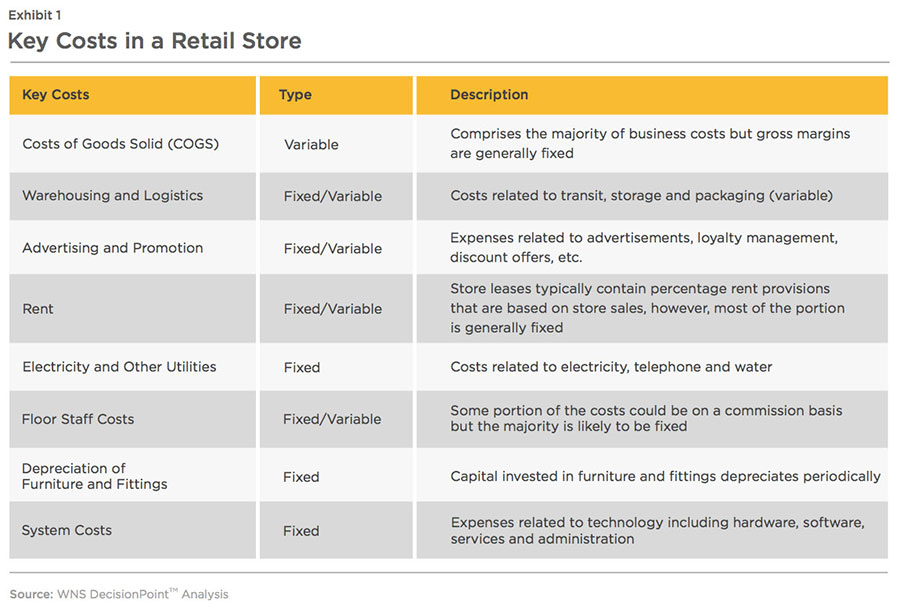
To make matters worse, the customer's purchase journey has totally transformed and is very unpredictable due to the advent of online shopping. The increase in customer touch-points (mobile apps, websites, social media, interactive voice response systems) apart from physical stores, have made the buying decision journey more complex, right from stimulation to research, purchase, fulfillment and after-sales service. Customers switch channels continuously, especially when searching for information on products and while buying.
To overcome this situation, many brick and mortar retailers adopted a multi-channel strategy for selling products, i.e. selling products through various channels such as physical stores, online websites and mobile applications. Each channel was managed and operated separately (in terms of customer relationship management, ordering, inventory, and so on), resulting in higher overall investments and inconsistent customer experiences across channels.
Omni-channel retailing has emerged to address the drawbacks of multi-channel retailing and the unpredictable buying behavior of customers. In an omni-channel model, irrespective of how, where, when or why consumers interact with the retailer, they are offered the same product selection, purchase and fulfillment options and level of service.
Omni-channel retailing is becoming the new normal in the retail industry and this means that companies, who are accustomed to delivering through either a single channel or through multiple disconnected channels, need to rethink their strategy of customer engagement.
The whole objective of omni-channel retailing is to enhance revenue growth and profitability amid high market saturation and rising Internet penetration, thereby, enhancing economic profit (Economic Value-Added or "EVA").
This research report attempts to identify the relationship between EVA and omni-channel retailing and draws up the implementation blueprint for delivering 'one' customer experience. Understanding the strategy roadmap (goals envisioned, execution capabilities for cross- channel buying, returns management, etc.) and infrastructural requirements (uniform product and price information across channels, single view of inventory and orders across the enterprise, aligned finance and supply chain processes) for being an omni-channel retailer is a necessary precursor for identifying the aforementioned relationship. The following report highlights all these points and lays down a clear roadmap for a converged retailing experience.
Omni-Channel Retailing - The Evolution
Increased internet usage and the rising penetration of mobile devices has redefined the customers purchase journey at every step, from building awareness, to driving consideration, and ultimately inspiring purchase. This has led to huge growth in the online sales market globally (refer Exhibit 3) as customers demand products anywhere, anytime and from any device.
Despite a high growth rate of ~18 per cent within the E-Retail market, the overall retail industry (including E-Retail) only grew by a paltry 5.3 percent in 2014ii, indicating that it is a two-paced growth paradigm.
An increasing preference for online buying has led to a huge number of retail store closures around the globe. RadioShack, running more than 1,700 electronic goods outlets in America, filed for bankruptcy in February 2015 prior to being acquired by a hedge fund, Standard Generaliii Wet Seal, an American clothing retailer, closed 338 stores in January 2015 to concentrate on its online businessiv. After a week or so, Wet Seal filed for Chapter 11 bankruptcy protection. Abercrombie & Fitch, another mall staple, closed ~60 stores in 2015 as leases expiredv.
As per Business Monitor International, a Fitch group company, there were around 3,500 shop closings announced in Q1 2015 in the U.S. alone, holding around 0.1 percent of the country's stockvi. Most of the downsizing was announced by fashion, household goods and consumer electronics retailers.
So does that mean the end of store based buying? No. Approached correctly, the online retail boom is a blessing in disguise for the wounded brick and mortar retailers. Traditional retailers have already focused or are in the process of strengthening their omni-channel capabilities in a bid to capitalize on the rising online retail market and ensure a seamless, on-demand customer experience. The idea behind this is to create a competitive advantage (in relation to online retailers), leveraging stores' fulfillment capabilities, with stores acting as a warehouse.
Increasing preference for online buying has led to a huge number of retail store closures around the globe.
As per Business Monitor International, a Fitch group company, there were around 3,500 shop closings announced in Q1 2015 in the U.S. alone, holding around 0.1 percent of the country's stock.
Traditional retailers' supply chain costs are roughly three times lower than pure play e-commerce companies considering the fulfillment capabilitiesvii. Beyond profitability, the increasing convenience of buy online and pickup/ship from store should maintain stores' significance. Moreover, stores present significant cross-selling and up-selling potential when a customer comes for pick up. The following figure (Exhibit 4) further highlights the importance of stores in ordering, fulfilling and receiving orders. There could be more than 100 different ways of ordering, fulfillment, and receiving products based on various channels depicted in Exhibit 4. ~82 percent of the ordering/fulfillment/ receiving decisions involve stores and 70 percent create store visits, making stores integral to the retailing businessviii.
In addition, stores are increasingly being equipped with technology to generate data and personalize the customer experience. For example:
- In-store touch screens provide customers with the full range of available products, a concept known as endless aisles
- Magic mirrors offer product information, recommendations, and virtual fittings
- Staff armed with customer data can practice clienteling, an approach by which they use data on individual customers' preferences and buying habits to create a customized in-store experience
- In-store navigation apps provide indoor turn-by-turn directions to help customers locate the products they are searching for
- Staff with mobile point of sale systems eliminate customer frustrations by allowing them to check out anywhere and avoid waiting in line
Other technologies such as mobile wallet, loyalty apps and customer tracking are also increasingly gaining popularity in stores across the customer's buying journey.
Physical stores are not the only ones implementing or strengthening their omni-channel initiatives. The need to possess omni-channel capabilities for pure-play e-commerce companies arises because of such stores' high involvement in buying and fulfillment decisions. In the age of free shipping, brick and mortar retailers have the existing infrastructure to leverage omni- channel capabilities and economies of scale to operate at higher profitability in relation to e-commerce companies. Key areas where store operators hold cost advantage over online companies include:
- Handling costs: Physical store operators generally tend to order in bulk and bear less handling costs as compared to expensive pick and pack shipping for E-Retailers.
- Shipping costs: Traditional retailers utilize economies of scale while shipping goods from distribution centers (DCs) to store. On the other hand, with the e-commerce direct to consumer approach, shipping parcels (from distribution centers) one at a time can be very costly. With integrated inventory, online orders can be shipped quicker from store to customer and are comparatively cheaper (compared to online companies) even after considering the handling costs and trucking costs from vendor to DC and DC to store respectively. For obvious reasons, buy online, pick-up in store (BOPS) results in no incremental shipping costs for the traditional retailer. In fact, BOPS may enhance cross-selling and up-selling opportunities in comparison to direct to consumer sale online.
Moreover, Internet penetration is still low in most parts of the world, and cognitive knowledge about products, service offerings, and such of all websites is even lower. Online retailers, such as Zaloraix (a fashion retailer) and FirstCryx (baby and kids' products), have already started integrating their 'click' and 'mortar' experience. Amazon opened its first offline store in the U.S. in February 2015xi. Flipkart, an Indian e-commerce company, launched 20 offline stores in July 2015 and planned to expand it to 100 by March 2016xii. Warby Parker and Bonobos are other notable examples of online retailers, who have opened offline stores.
Omni-Channel Management - The Rise Of New Leaders
With the convergence of digital and physical shopping channels increasing the buying power of consumers more than ever before, retailers, who want to deliver on the promise of limitless product delivery (fulfillment) concerning time and place at the lowest cost, need to drive synchronization and alignment across all channels.
The retail organization needs to be restructured in order to support the omni-channel model. Generally, in successful omni-channel retail, a leader is assigned the responsibility of providing a unified vision and accomplishing the integration. For instance, Macy's has hired a Chief Omni-Channel Officer (COCO), to oversee systems and technology, and logistics and related operations integration across various customer-facing channels. Other retailers such as Finish Line and The Bon Ton stores, have also created COCO positions. Office Depot, American Eagle Outfitters and Zumiez are a few more retailers who have created omni- channel related positions. And, as retailers become more keen to establish a proactive, agile and responsive operating model to deliver a consistent brand experience across channels, the industry expects an even greater number of executives with omni- channel titles and similar roles to emerge over the next few years.
Senior Management Sponsorship Key To Omni-Channel Overhaul
Omni-channel retailing leads to many changes, and a good omni-channel leader must work in close collaboration across the retail business. Managing the complex shift to omni-channel retailing starts at the top, with leaders making clear to everyone the goals and objectives of the restructuring (see Exhibit 5).
The above objectives mainly target improving the back-end to front-end operations (Exhibit 6) in order to support the company's omni-channel ambition.
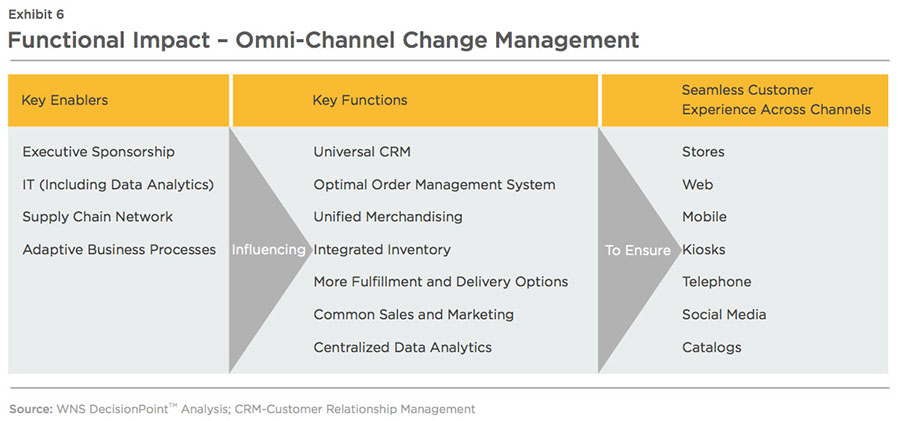
Omni-Channel Implementation - The Requirements
Apart from having flexible front- end operations sales, marketing, customer care and customer facing technologies (mobile, kiosks and web-stores) retailers need a robust back-end infrastructure that includes customer relationship management, order management, catalog management, inventory allocation and assortment, and reverse logistics. Back-end systems form the backbone of omni- channel retailing. Disparate platforms, processes and IT architectures, if any, should be consolidated and standardized to remove inefficiencies. Back-end capabilities should be integrated with front-end operations and technologies across all customer touch-points to create robust customer engagement. Some of the important back-end operations are listed below in Exhibit 7:
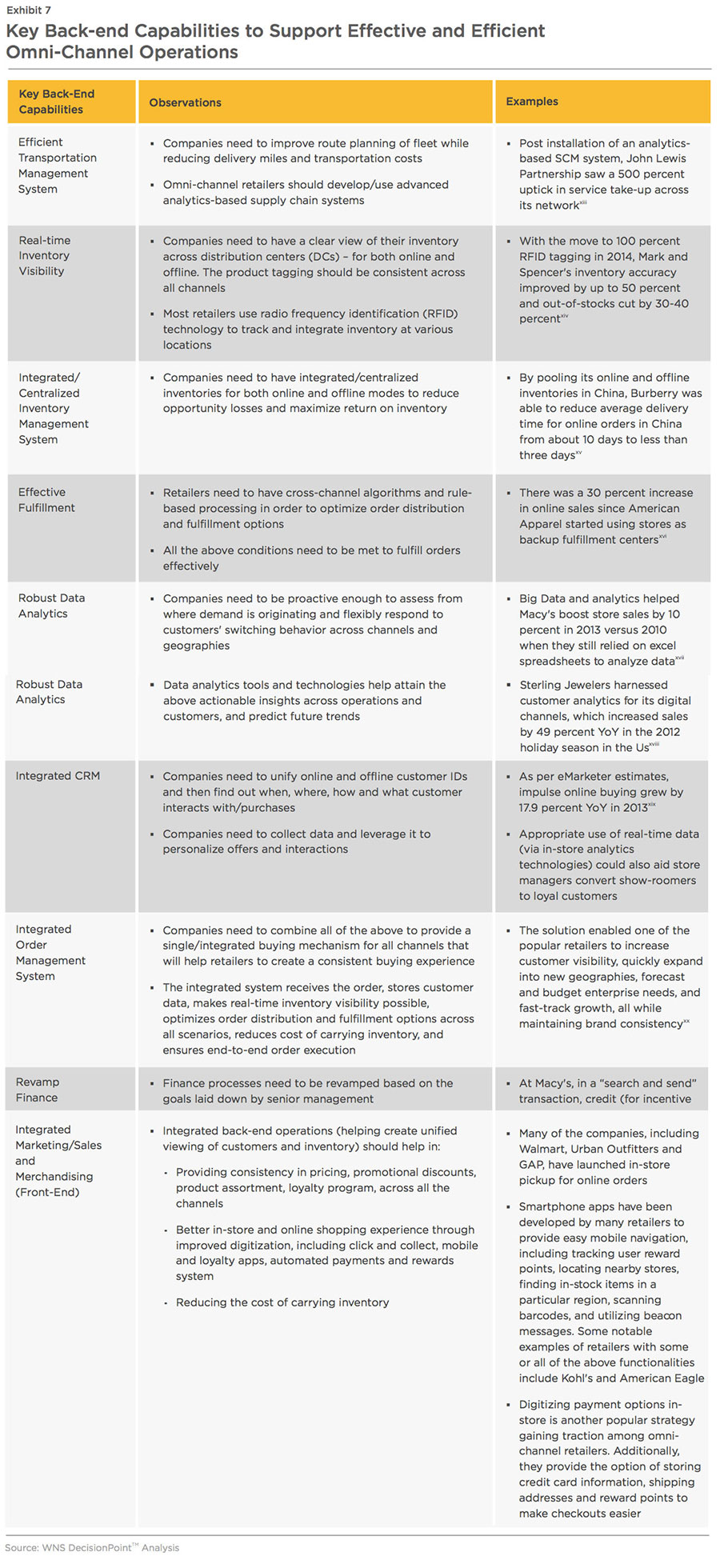
Retailers should leverage common Web services to integrate back-end systems with front-end operations Application programming interface aids provide order history, customer data, inventory availability and pricing related information consistently across all customer touch-points. This strong visibility and information sharing of customer and inventory data across channels enables a seamless customer experience. Retailers with omni-channel ambitions have been aggressively investing in IT and supply chain functionalities in light of this requirement. Apart from integrating the inventory and customer related information systems, the investments are also focused around having
- more customer touch-points - online, mobile, stores, drive-throughs, lockers, kiosks
- more and aggressive delivery options - same day delivery, pick-up within 2 hours, after hours delivery, time slot deliveries
- digitized payment options - Apple Pay, PayPal and others, and a proprietary mobile wallet (in mobile apps)
- flexible delivery points - curbside, train stations, workplace, home
- additional pick-up services - reserve online, self-collect, drive-through, endless aisle
Big retailers have earmarked huge investments for augmenting omni- channel capabilities.
Exhibit 8 highlights the investment plans of these players.
Retailers are integrating back-end systems to manage all types of data, including those related to inventory, customer and fulfilment in order to create an omni-channel experience. The IT and distribution shares of specialty retail capital expenditures increased ~10 percentage points between 2011 and 2013 (see Exhibit 9). Omni-channel related CapEx (for specialty retailers) accounts for 45 percent of all investment spending after increasing 20 percent YoY in FY13.
Understanding Omni-Channel Behavior During The Customer Purchase Journey Is Critical
Along with creating a unified view of inventory and customers, equally critical for omni-channel retailing is to correctly recognize the customer behavior during the purchase journey and its relation to socio-demographics and psychographics. There could be many factors apart from demographics, which could influence omni-channel shopping behavior, such as channel knowledge, shopping orientation, service and product experience, channel-risk perceptions, price- search intentions, search effort, delivery time and more. For example, young and innovative consumers are likely to have a higher use of online channels, including social media, in their buying journey. Consumers with higher incomes are more likely to use mobile applications for research and buying. Once the relationship is identified between socio-demographics/ psychographics and omni-channel shopping behavior, various typologies (customer segments) could be created based on similar preferences, buying habits, reactions to marketing activities and such. Retailers should consider these typologies in order to offer the right mix of information during the customer purchase journey through various channels, including mobile applications and social media networks.
A key requirement to understanding omni-channel shopping behavior and imparting right information to right customers via right channel is to have an integrated CRM for all customer interactions including purchases across channels. Almost all the retail organizations now have the capability to handle telephone conversations, tweets, emails, Facebook responses, live chat in mobile/Web etc. The enterprises need to place greater importance on the two-way exchange of value between customer and enterprise in terms of interactions, transactions and service cases to provide right information via right channel. In response to this, many of the retail organizations have invested in a variety of CRM tools and technologies related to customer service and support, such as those related to social CRMs, web/mobile campaign management and tracking, content management and analytics solutions. But the main test is to connect these tools with the right business processes, rule engines, real-time decisions, and interaction-routing engines to enable a seamless customer experience. IT, marketing, sales, logistics, customer service and other departments will need to work together to make this happen. Integrating all these CRM tools and technologies will aid retailers in creating a single customer view and help them personalize service/product offerings (price, quality, design, color etc.) using data analytics tools and technologies. In addition to all this, providing employees (customer-care representatives, in-store sales person etc.) with relevant skills, knowledge and technologies and tools to access customer data is necessary. No amount of technological innovation can change anything without proficient employees using it.
Key activities carried out by omni-channel retailers to ensure seamless customer experience
- Imparting regular training on omni-channel customer engagement to customer care representatives, in-store sales persons, product delivery people and other customer-facing personnel so that they can provide a personalized and context-appropriate experience
- Matching right customer with the right employee who has the relevant skills to handle precise needs of each client
- High utilization of customer data from past interactions for current/future engagement
- Regularly measuring the performance of above programs via financial and operational metrics
Omni-Channel Retail And Economic Profit - The Connection
Target Corporation ( Target ) has identified that a customer, who shops both in-store and digitally shops three times more frequently, generating three times more sales and over 2.5 times more margin dollars, compared to a store-only customer. Not only that, Target also found out that in-store sales from multi-channel customers was much higher than from in-store only customers. This clearly shows that omni-channel retailing is likely to enhance revenue growth. However, the analysis does not factor in the investments made and the associated opportunity costs. WNS DecisionPoint™ developed an omni-channel coefficient to ascertain the omni-channel readiness of a company and compared that with the economic value added (EVA) of that company, to assess the connection between the two.
- WNS DecisionPoint™ considered 10 parameters related to improving in-store and online experience (including buy online pick-up in store, ship from store, store inventory viewing via mobile, same day delivery, home delivery for out-of-stock products (in store), return online purchases to store, mobile navigation (including store locator), reserve store inventory online, interact with brand on social media, and self-checkout (including via phone)) to derive an omni-channel coefficient (OCC)
- The OCC will help identify the readiness of retailers to provide consistent brand messaging, continuous engagement and seamless experience across channels
- These parameters (OCCs) might not be available for every store belonging to the companies, but they give a directional indication about their omni-channel retailing pursuits
- Please note that there could be additional readiness variables that may impact the OCC
- We have calculated the EVA of the companies in focus and tried to ascertain whether a higher OCC has been able to generate a higher economic value for the shareholders
Let's see the connection between omni-channel retail and EVA in Exhibit 10.
Unsurprisingly, most of the Innovators (OCC between four and five) and Followers (OCC between three and four) led from the front, in terms of economic value accretion, while most of the risk averse retailers (OCC < 3 ) reported value erosion - proving that omni- channel retailing is really value accretive (See Exhibit 11).
On an average, the innovators added 2.9 percentage points (PPs) value, and followers reported 2.46 PPs increase while the risk averse conceded -0.67 PPs from their investors' wallet. For Innovators, the value accretion was primarily the result of a better EBIT Margin with five out of the six Innovators reporting higher than average numbers. This is because of higher customer retention and conversion (high online/store visits turning into a sale) ratio, given the seamless experience that advanced omni-channel capabilities provide to customers, leading to reduction in selling and marketing costs. According to a Cowen Customer Tracking Survey, Walmart's monthly conversion (based on 12 months moving average) has gone up from 32.5 percent in December 2013 to 34.6 percent in February 2015. Macy's witnessed an uptick of 4.7 percentage points to 32.8 percent during the same period. Four out of the six Followers reported higher capital turnover ratio than average. They tend to generate higher revenue per unit of invested capital as increasing number of consumers are now being able to leverage omni-channel capabilities and, hence, spending is more, leading to higher capital utilization. EBIT margins are lower for the Follower group since investments in omni- channel capabilities is on the rise (four out of the six Followers have lower than average numbers).
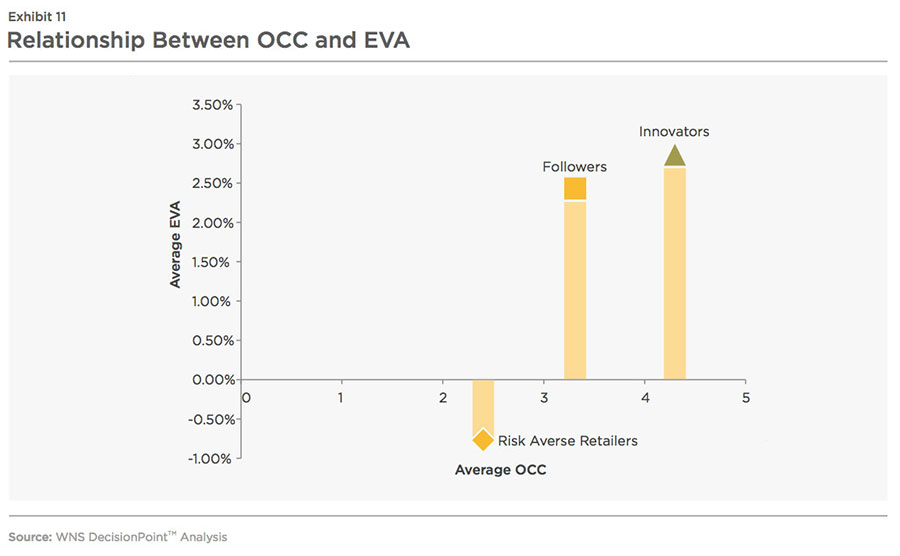
To further highlight the connection between omni-channel retail and economic profit, let's study Target Corporation's (whose omni-channel initiatives have been explained briefly above) evolution as an omni-channel retailer and the corresponding change in economic profit, as evident in Exhibit 12 and 13.
Target's omni-channel retailing pursuit started gaining traction from FY 2012 onwards. The results of the initiatives were visible during the last few years with Target maintaining return on capital (ROC) levels above 10 percent (despite heightened competition from e-commerce companies) and being consistently able to enhance EVA especially during FY 2014 and FY 2015 (Refer Exhibit 14). This could be primarily attributable to its improving omni-channel capabilities leading to higher customer spending (Target's omni-channel customers spend 3x more than customers buying from stores only) resulting in improved capital utilization.
Target believes that digital engagement creates additional store trips and sales (and therefore more profits) as the customer develops a deeper relationship with the company, making the case for omni-channel retailing even stronger.
A variety of other examples could also be quoted to depict the gradual enhancement in shareholder value when the retailers start moving up on the omni-channel capabilities scale. The above-mentioned retailers (Innovators, Followers and Risk Averse retailers) might not have implemented omni-channel capabilities in all the stores as of now, but they are rapidly adopting the same across their operations given its benefits.
Supporting Omni-Channel Things To Consider
For an omni-channel strategy to work, a customer's purchase journey must be mapped out to personalize communication effectively across each buying step to make the consumer feel more valued. Before using data analytics, retailers need to have a unified view of their customers to shell out personalized offers (including loyalty schemes) and offer the right information across all channels. Robust SCM systems including logistics and inventory management are also needed to support the limitless product delivery model concerning time and place. The following table (Exhibit 15) highlights the things that need to be in place including the aforementioned areas to support the omni-channel retail model.
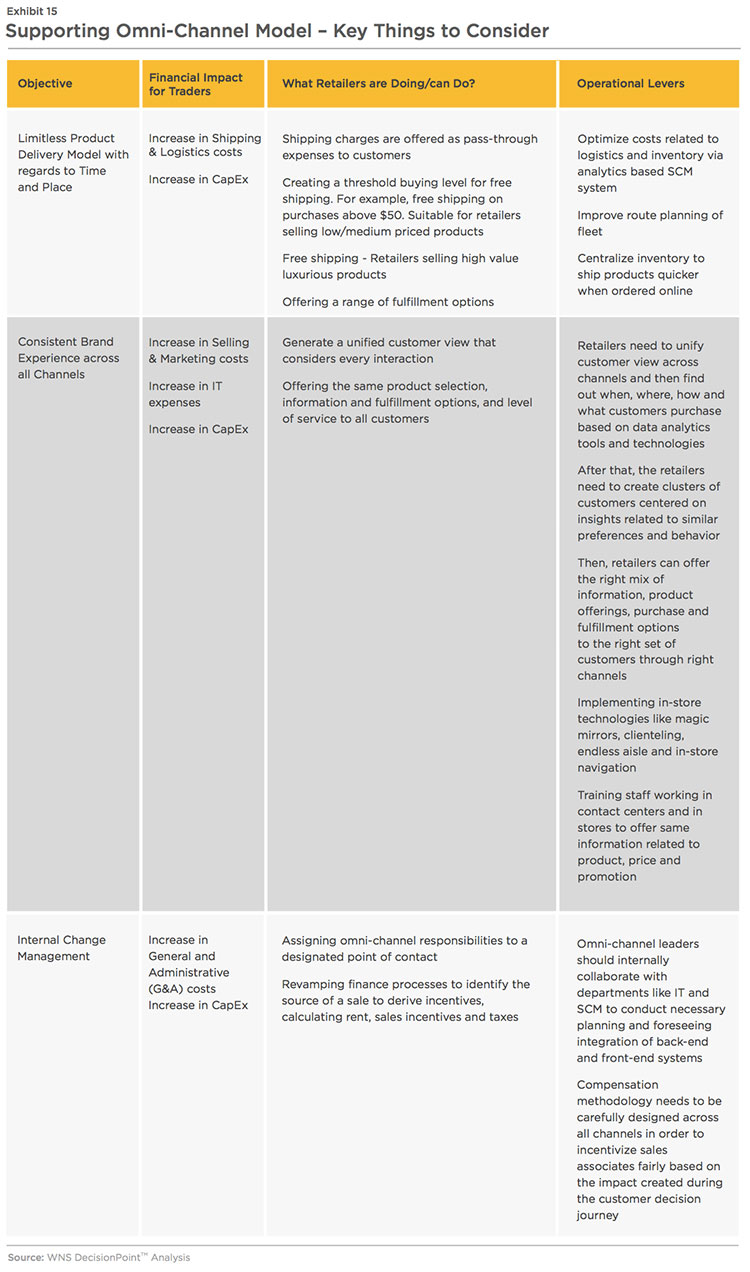
An Omni-Channel Future - The Roadmap
Omni-channel retailing adoption is synonymous with economic profit creation, as seen above. While most companies have already started their journey towards omni- channel retailing, all the companies should have a clear roadmap to achieve the desired end state. Below are the key steps companies should be taking to make their way toward a fully implemented omni- channel retail model:
- Assign omni-channel responsibilities to a designated point of contact with well- defined financial targets
- Redesign organizational structure in such a way that channel specific requirements (mainly operational) remain intact
- Assess the readiness of the IT, SCM and Shared Services team to implement omni-channel capabilities (both back-end as well as front-end) by conducting internal and external benchmarking
- Develop a transformation strategy to move to the desired level and realign process and technology investments to drive synchronization and alignment across all customer channels appoint an in-house implementation team or engage with external consultants
- Decide on the functions that need to be outsourced or retained in-house. Common outsourceable processes include data analysis (customer, marketing, sales and supply chain management), finance and accounting, omni-channel customer relationship management, trade promotion optimization and management services. On the IT and SCM side, installation of transport management systems, order management systems and data analytics tools and technologies can be managed by specialist third party service providers
- Consistently track and measure the progress of omni-channel progress across channels using relevant key performance indicators and objectives
By doing all this, companies will achieve a converged retailing experience, have more satisfied customers, and increase economic value added.
References:
i. Article by eMarketer, Retail Sales Worldwide will Top $22 Trillion this Year, 2014
ii. Blog by Euromonitor International, Global Retailing Sales to Reach US$19.6 Trillion by 2019, 2014
iii. News by NewBay Media, Court Approves RadioShack Sale, 2015
iv. Article by Entrepreneur, Wet Seal Just Made Two- Thirds of Its Stores Disappear, 2015
v. News by Retail TouchPoints, Store Openings Highlight Q4 Financial Results, 2015
vi. Report by Business Monitor International, BMI Industry View - United States - Q4 2015, 2015
vii. Report by Cowen and Company, Bricks + Clicks: The Digital Download on Omni-Channel, 2015
viii. Investor Presentation by Hudson s Bay Company, Bank of America Consumer & Retail Conference, 2015
ix. Article by PowerRetail, Zalora Pop-Up Store Connecting Offline and Online, 2015
x. Interview by VCCircle, We will have 100 offline stores in India by the end of this year - FirstCry CEO Supam Maheshwari, 2014
xi. News by thegurardian, Amazon begins a new chapter with opening of first physical bookstore, 2015
xii. News by Economic Times, Flipkart now allows to pick up your purchases from 20 offline experience zones, 2015
xiii. Report by Clearwater International, Global Supply Chain Management Software Market Report, 2014
xiv. News by Retail Technology, Accurate inventory tracking benefits M&S, 2014
xv. News by Internet Retailer, Burberry pools its online and offline inventory in China, 2015
xvi. Report by Kurt Salmon, The Core of Omnichannel Retailing, 2013
xvii. News by CNBC, Retail Goes Shopping Through Big Data, 2013
xviii. Blog by Retail TouchPoints, Signet Jewelers Increases Online Sales by 49% With Improved Cross-Channel Experience, 2013
xix. Article by Bloomberg, Retailers Use Big Data to Turn You into a Big Spender, 2014
xx. Report by Retail TouchPoints, Building Omni- Channel Retail from the Back End Up
xxi. Article by CohnReznick LLP, Omni-Channel: What Retail CFOs Should Be Thinking About Now, 2013
Acknowledgements:
a) Report by Cowen and Company, Bricks + Clicks - The Digital Download On Omni-Channel, 2015
b) Report by Kurt Salmon, The Core of Omnichannel Retailing, 2013
c) Report by Kurt Salmon, Don't Call It Omnichannel, 2014
d) Report by W.C.J.M. (Lieke) van Delft, Omni Channel Shopping Behavior During the Customer Journey, 2013
e) Report by Boston Technology Group, BCG Technology Advantage, 2015
f) Annual Reports of Top Retailers